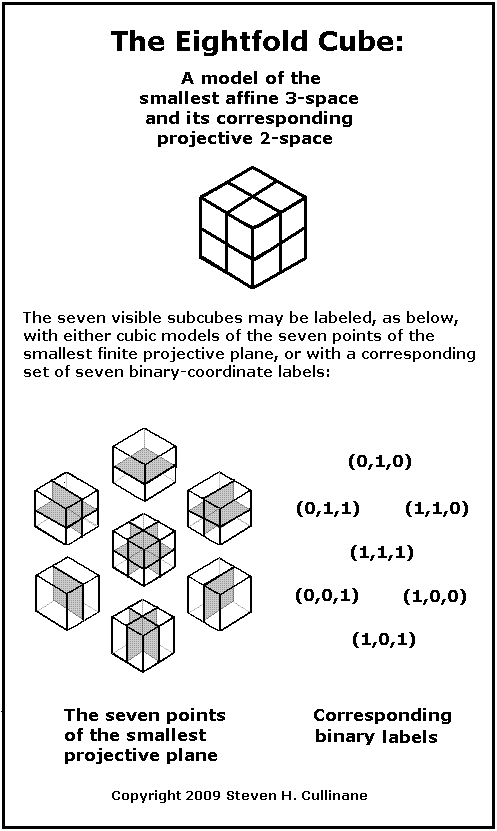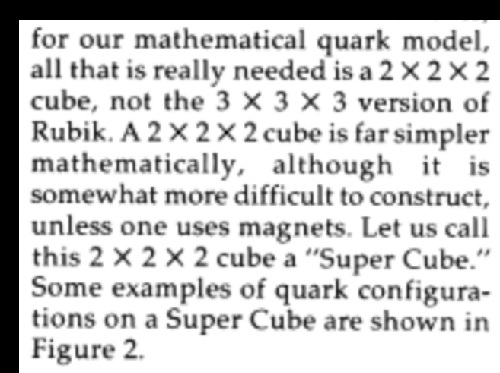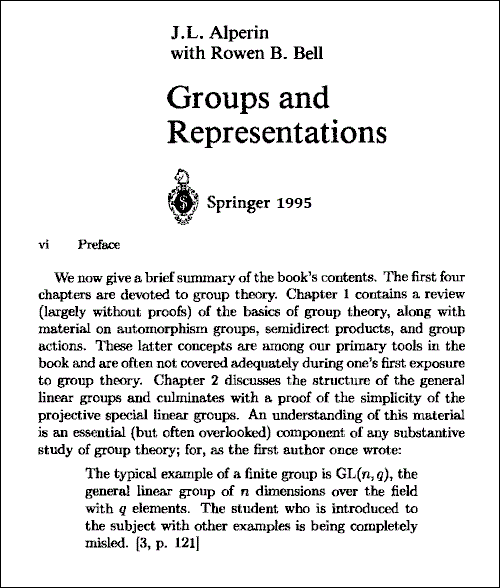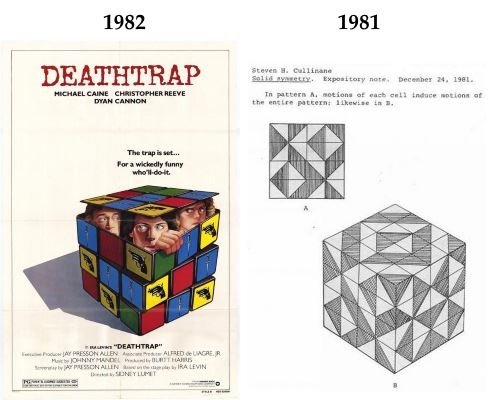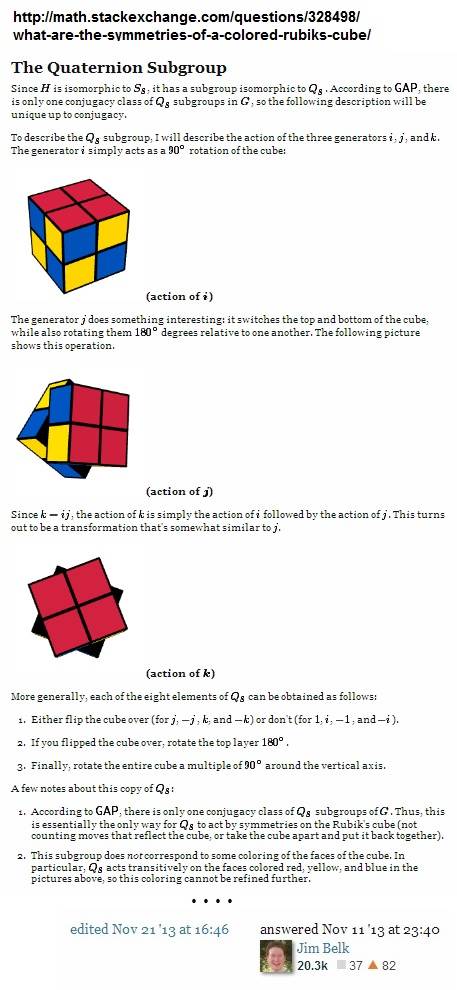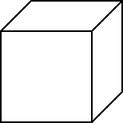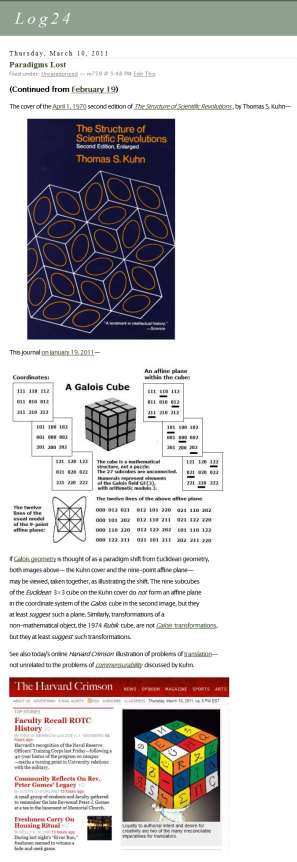Click to enlarge.
Saturday, February 26, 2022
Thursday, June 30, 2016
Rubik vs. Galois: Preconception vs. Pre-conception
From Psychoanalytic Aesthetics: The British School ,
by Nicola Glover, Chapter 4 —
|
In his last theoretical book, Attention and Interpretation (1970), Bion has clearly cast off the mathematical and scientific scaffolding of his earlier writings and moved into the aesthetic and mystical domain. He builds upon the central role of aesthetic intuition and the Keats's notion of the 'Language of Achievement', which
… includes language that is both Bion distinguishes it from the kind of language which is a substitute for thought and action, a blocking of achievement which is lies [sic ] in the realm of 'preconception' – mindlessness as opposed to mindfulness. The articulation of this language is possible only through love and gratitude; the forces of envy and greed are inimical to it.. This language is expressed only by one who has cast off the 'bondage of memory and desire'. He advised analysts (and this has caused a certain amount of controversy) to free themselves from the tyranny of the past and the future; for Bion believed that in order to make deep contact with the patient's unconscious the analyst must rid himself of all preconceptions about his patient – this superhuman task means abandoning even the desire to cure . The analyst should suspend memories of past experiences with his patient which could act as restricting the evolution of truth. The task of the analyst is to patiently 'wait for a pattern to emerge'. For as T.S. Eliot recognised in Four Quartets , 'only by the form, the pattern / Can words or music reach/ The stillness'.30. The poet also understood that 'knowledge' (in Bion's sense of it designating a 'preconception' which blocks thought, as opposed to his designation of a 'pre -conception' which awaits its sensory realisation), 'imposes a pattern and falsifies'
For the pattern is new in every moment The analyst, by freeing himself from the 'enchainment to past and future', casts off the arbitrary pattern and waits for new aesthetic form to emerge, which will (it is hoped) transform the content of the analytic encounter. 29. Attention and Interpretation (Tavistock, 1970), p. 125 30. Collected Poems (Faber, 1985), p. 194. 31. Ibid., p. 199. |
See also the previous posts now tagged Bion.
Preconception as mindlessness is illustrated by Rubik's cube, and
"pre -conception" as mindfulness is illustrated by n×n×n Froebel cubes
for n= 1, 2, 3, 4.
Suitably coordinatized, the Froebel cubes become Galois cubes,
and illustrate a new approach to the mathematics of space .
Wednesday, June 15, 2016
Rubik’s Deathtrap
The previous post suggests a search in this journal
for "Deathtrap."
"Rubik’s Cube® used by permission
Rubik’s Brand Ltd. www.rubiks.com."
— Bernd Sturmfels, June-July 2016 Notices
of the American Mathematical Society ,
Volume 63, Number 6, page 605
"Tenser, said the Tensor …." — The Demolished Man

Max von Sydow in Branded (2012)
Monday, May 19, 2014
Rubik Quote
“The Cube was born in 1974 as a teaching tool
to help me and my students better understand
space and 3D. The Cube challenged us to find
order in chaos.”
— Professor Ernő Rubik at Chrome Cube Lab
For a Chinese approach to order and chaos,
see I Ching Cube in this journal.
Friday, September 9, 2011
Galois vs. Rubik
(Continued from Abel Prize, August 26)
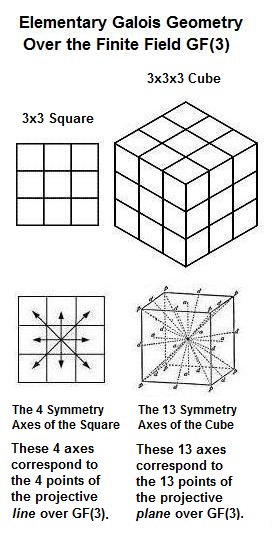
The situation is rather different when the
underlying Galois field has two rather than
three elements… See Galois Geometry.

The coffee scene from “Bleu”
Related material from this journal:
The Dream of
the Expanded Field

Tuesday, October 24, 2023
Friday, October 13, 2023
Hungarian Puzzle
See "Cube Space" + Lovasz.
This search was suggested by . . .
The conclusion of Solomon Golomb's
"Rubik's Cube and Quarks,"
American Scientist , May-June 1982 —
Sunday, June 4, 2023
The Galois Core
Monday, November 28, 2022
Groups, Spaces, and Ripoffs
"Rubik's Cube, and the simpler [2x2x2] Super Cube, represent
one form of mathematical and physical reality."
— Solomon W. Golomb, "Rubik's Cube and Quarks:
Twists on the eight corner cells of Rubik's Cube
provide a model for many aspects of quark behavior,"
American Scientist , Vol. 70, No. 3 (May-June 1982), pp. 257-259
From the last (Nov. 14, 2022) of the Log24 posts now tagged Groups and Spaces —
From the first (June 21, 2010) of the Log24 posts now tagged Groups and Spaces —
Friday, May 27, 2022
Plan 9 from Disney
"With the Tablet of Ahkmenrah and the Cube of Rubik,
my power will know no bounds!"
— Kahmunrah in a novelization of Night at the Museum:
Battle of the Smithsonian , Barron's Educational Series
Scholium —
Abstracting from narrative to structure, and from structure
to pure number, the Tablet of Ahkmenrah represents the
number 9 and the Cube of Rubik represents the number 27.
Returning from pure abstract numbers to concrete representations,
9 yields the structures in Log24 posts tagged Triangle.graphics,
and 27 yields a Galois cube .
Tuesday, May 24, 2022
Playing the Palace
From a Jamestown (NY) Post-Journal article yesterday on
"the sold-out 10,000 Maniacs 40th anniversary concert at
The Reg Lenna Center Saturday" —
" 'The theater has a special place in our hearts. It’s played
a big part in my life,' Gustafson said.
Before being known as The Reg Lenna Center for The Arts,
it was formerly known as The Palace Theater. He recalled
watching movies there as a child…."
This, and the band's name, suggest some memories perhaps
better suited to the cinematic philosophy behind "Plan 9 from
Outer Space."

"With the Tablet of Ahkmenrah and the Cube of Rubik,
my power will know no bounds!"
— Kahmunrah in a novelization of Night at the Museum:
Battle of the Smithsonian , Barron's Educational Series
The above 3×3 Tablet of Ahkmenrah image comes from
a Log24 search for the finite (i.e., Galois) field GF(3) that
was, in turn, suggested by last night's post "Making Space."
See as well a mysterious document from a website in Slovenia
that mentions a 3×3 array "relating to nine halls of a mythical
palace where rites were performed in the 1st century AD" —
Sunday, May 1, 2022
Jailbait Puzzle for Moon Knight


The pane number of interest — 15 or 14 ? —
depends on your perspective.
Related cinematic art of Oscar Isaac —

Wednesday, March 30, 2022
Friday, February 4, 2022
The Guralnik Cube
New York Review of Books , Dec. 16, 2021 issue —
Lorrie Moore on the documentary series "Couples Therapy" —
"Few of the people sitting on the couch avoid the cliché of
one person (a man) playing fruitlessly with a plastic puzzle
while the other speaks tearfully and avails herself of a
Kleenex box. In season 1, there is literally a Rubik’s cube,
and no one ever solves it, an unfortunate but apt metaphor.
During one session, when the cube has been placed out of reach,
one of the husbands gets up to look for it, finding it on a shelf."
See also . . .
"The bond with reality is cut." — Hans Freudenthal
Monday, January 31, 2022
The Prime Mover
"Metaphor in language — the prime mover"
— George Steiner in Real Presences (1989)
Not so prime —
See also the "Transformers" marketing saga.
Related marketing:
Disney Easter eggs —
Friday, December 31, 2021
Aesthetics in Academia
Related art — The non-Rubik 3x3x3 cube —
The above structure illustrates the affine space of three dimensions
over the three-element finite (i.e., Galois) field, GF(3). Enthusiasts
of Judith Brown's nihilistic philosophy may note the "radiance" of the
13 axes of symmetry within the "central, structuring" subcube.
I prefer the radiance (in the sense of Aquinas) of the central, structuring
eightfold cube at the center of the affine space of six dimensions over
the two-element field GF(2).
Saturday, August 28, 2021
Solomon’s Super* Cube…
Geometry for Jews continues.
The conclusion of Solomon Golomb's
"Rubik's Cube and Quarks,"
American Scientist , May-June 1982 —
Related geometric meditation —
Archimedes at Hiroshima
in posts tagged Aitchison.
* As opposed to Solomon's Cube .
Wednesday, January 27, 2021
Adoration of the Cube . . .

Related vocabulary —
See as well the word facet in this journal.
Analogously, one might write . . .
A Hiroshima cube consists of 6 faces ,
each with 4 squares called facets ,
for a total of 24 facets. . . ."
(See Aitchison's Octads , a post of Feb. 19, 2020.)

Click image to enlarge. Background: Posts tagged 'Aitchison.'"
Sunday, September 20, 2020
Epistemological Metaphor
Friday, September 18, 2020
Adoration of the Cube
“WHEN I IMAGINE THE CUBE, I see a structure in motion.
I see the framework of its edges, its corners, and its flexible joints,
and the continuous transformations in front of me (before you start
to worry, I assure you that I can freeze it anytime I like). I don’t see
a static object but a system of dynamic relations. In fact, this is only
half of that system. The other half is the person who handles it.
Just like everything else in our world, a system is defined by
its place within a network of relations—to humans, first of all.”
— Rubik, Erno. Cubed (p. 165). Flatiron Books. Kindle Ed., 2020.
Compare and contrast — Adoration of the Blessed Sacrament.
Thursday, September 17, 2020
Structure and Mutability . . .
Continues in The New York Times :
“One day — ‘I don’t know exactly why,’ he writes — he tried to
put together eight cubes so that they could stick together but
also move around, exchanging places. He made the cubes out
of wood, then drilled a hole in the corners of the cubes to link
them together. The object quickly fell apart.
Many iterations later, Rubik figured out the unique design
that allowed him to build something paradoxical:
a solid, static object that is also fluid….” — Alexandra Alter
Another such object: the eightfold cube .
Friday, September 4, 2020
Vox Lux
An illustration from the Vox article —
Another approach to Nolan theory —
Or Matt Helm by way of a Jedi cube.
Tuesday, March 10, 2020
Labeling a Cuboctahedron

The above arrangement of graphic images on cube faces is purely
decorative and static, and of little mathematical interest.
(A less static, but structurally chaotic, artifact might be made by
pasting the above 24 graphic images in the "Cosets in S4" picture
above onto the 24 faces of a 2x2x2 Rubik cube. This suggests the
reflection below on the poet Wallace Stevens, whose "Connoisseur
of Chaos" first appeared on page 90 of Twentieth Century Verse ,
Numbers 12-13, October 1938.)
If mathematically interesting permutations of the graphic images
are to be done, the images should be imagined as situated on
parallel planes, as in the permutahedron below —
Click the above permutahedron for an analysis of its structure.
Wednesday, July 31, 2019
Icelandic Fantasy
"In the fantasy, Owen is still working on his Rubik’s Cube.
Finally, he finishes — he’s put together all 6 sides."
— "Maniac" Season 1, Episode 9 recap: ‘Utangatta’
by Cynthia Vinney at showsnob.com, Oct. 9, 2018
Related material —


See also Exploded in this journal.
Thursday, June 27, 2019
Group Actions on the 4x4x4 Cube
For affine group actions, see Ex Fano Appollinis (June 24)
and Solomon's Cube.
For one approach to Mathieu group actions on a 24-cube subset
of the 4x4x4 cube, see . . .
For a different sort of Mathieu cube, see Aitchison.
Friday, October 19, 2018
Kaleidoscope and Old Lace
See posts now tagged "Kaleidoscope Society" and, more generally,
a search in this journal for "Kaleidoscope."
Related material —
Photo caption in a news story today:
"Father Gary Thomas attends the premiere of Warner Brothers’
'The Rite' at Grauman’s Chinese Theatre, in Los Angeles,
on January 26, 2011. Thomas is holding a special Mass
on Thursday and Saturday [Oct. 18 and 20] to counter
a planned hex on Supreme Court Justice Brett Kavanaugh."
See as well posts tagged "Rubik Exorcism."
Sunday, September 30, 2018
Iconology of the Eightfold Cube
Found today in an Internet image search, from the website of
an anonymous amateur mathematics enthusiast —
Forming Gray codes in the eightfold cube with the eight
I Ching trigrams (bagua ) —
This journal on Nov. 7, 2016 —
A different sort of cube, from the makers of the recent
Netflix miniseries "Maniac" —

See also Rubik in this journal.
Monday, August 27, 2018
Children of the Six Sides
From the former date above —
|
Saturday, September 17, 2016 |
From the latter date above —
|
Tuesday, October 18, 2016
Parametrization
|
From March 2018 —
Wednesday, August 15, 2018
An Illusion of Brilliance
” . . . the 3 by 3, the six-sided, three-layer configuration of
the original Rubik’s Cube, which bestows an illusion of brilliance
on those who can solve it.”
— John Branch in the online New York Times today,
“Children of the Cube”:
https://www.nytimes.com/2018/08/15/sports/
cubing-usa-nationals-max-park.html
Cube-solving, like other sports, allows for displays of
impressive and admirable skill, if not “brilliance.”
The mathematics — group theory — that is sometimes associated
with Rubik’s Cube is, however, not a sport. See Rubik + Group
in this journal.
Saturday, March 31, 2018
Illusion
“The greatest obstacle to discovery
is not ignorance —
it is the illusion of knowledge.”
— Daniel J. Boorstin,
Librarian of Congress,
quoted here in 2006.
Related material —
Remarks on Rubik’s Cube from June 13, 2014 and . . .

See as well a different Gresham, author of Nightmare Alley ,
and Log24 posts on that book and the film of the same name .
Wednesday, March 28, 2018
On Unfairly Excluding Asymmetry
A comment on the the Diamond Theorem Facebook page —


Those who enjoy asymmetry may consult the "Expert's Cube" —
For further details see the previous post.
Tuesday, March 27, 2018
Compare and Contrast
Related material on automorphism groups —
The "Eightfold Cube" structure shown above with Weyl
competes rather directly with the "Eightfold Way" sculpture
shown above with Bryant. The structure and the sculpture
each illustrate Klein's order-168 simple group.
Perhaps in part because of this competition, fans of the Mathematical
Sciences Research Institute (MSRI, pronounced "Misery') are less likely
to enjoy, and discuss, the eight-cube mathematical structure above
than they are an eight-cube mechanical puzzle like the one below.
Note also the earlier (2006) "Design Cube 2x2x2" webpage
illustrating graphic designs on the eightfold cube. This is visually,
if not mathematically, related to the (2010) "Expert's Cube."
Wednesday, June 21, 2017
Detail for Hopkins
Detail from the previous post —

See Space Cross in this journal.
See also Anthony Hopkins' new film
"Transformers: The Last Knight" and …
Wednesday, June 29, 2016
Space Jews
For the Feast of SS. Peter and Paul —

In memory of Alvin Toffler and Simon Ramo,
a review of figures from the midnight that began
the date of their deaths, June 27, 2016 —
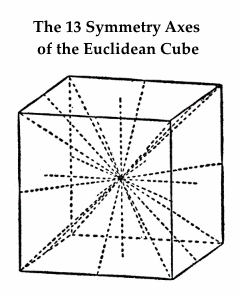

The 3×3×3 Galois Cube
See also Rubik in this journal.
Sunday, June 26, 2016
Common Core versus Central Structure
Rubik's Cube Core Assembly — Swarthmore Cube Project, 2008 —
"Children of the Common Core" —
There is also a central structure within Solomon's Cube —

For a more elaborate entertainment along these lines, see the recent film
"Midnight Special" —
Wednesday, June 15, 2016
Expanding the Spielraum …

"My AMS invited address at the SIAM Annual Meeting July 11–15
in Boston discusses the extension of eigenvectors and singular
vectors from matrices to higher order tensors."
— Bernd Sturmfels in the June-July 2016 AMS Notices
See also Sturmfels in this journal — for instance, in
"Expanding the Spielraum," a post of Feb. 3, 2015 —
Monday, April 25, 2016
Monday, April 4, 2016
Cube for Berlin
Foreword by Sir Michael Atiyah —
"Poincaré said that science is no more a collection of facts
than a house is a collection of bricks. The facts have to be
ordered or structured, they have to fit a theory, a construct
(often mathematical) in the human mind. . . .
… Mathematics may be art, but to the general public it is
a black art, more akin to magic and mystery. This presents
a constant challenge to the mathematical community: to
explain how art fits into our subject and what we mean by beauty.
In attempting to bridge this divide I have always found that
architecture is the best of the arts to compare with mathematics.
The analogy between the two subjects is not hard to describe
and enables abstract ideas to be exemplified by bricks and mortar,
in the spirit of the Poincaré quotation I used earlier."
— Sir Michael Atiyah, "The Art of Mathematics"
in the AMS Notices , January 2010
Judy Bass, Los Angeles Times , March 12, 1989 —
"Like Rubik's Cube, The Eight demands to be pondered."
As does a figure from 1984, Cullinane's Cube —
For natural group actions on the Cullinane cube,
see "The Eightfold Cube" and
"A Simple Reflection Group of Order 168."
See also the recent post Cube Bricks 1984 —
Related remark from the literature —

Note that only the static structure is described by Felsner, not the
168 group actions discussed by Cullinane. For remarks on such
group actions in the literature, see "Cube Space, 1984-2003."
(From Anatomy of a Cube, Sept. 18, 2011.)
Monday, February 9, 2015
Escape Clause
For Jews of Hungarian background
who do not worship Paul Erdős and
Rubik’s Cube:
Sunday, February 8, 2015
Hungarian Phenomenon
For Autism Sunday —
Mathematician John von Neumann
reportedly died on this date.
“He belonged to that so-called
Hungarian phenomenon….”
— A webpage titled
“Von Neumann, Jewish Catholic”
Illustrations of another Hungarian phenomenon:
Monday, December 29, 2014
Revolution of Forms
In memory of Cuban architect
Ricardo Porro, who died
on Christmas Day, 2014:
See also Rubik + Revolution
and Launched from Cuber.
Friday, November 14, 2014
Another Opening, Another Show
“What happens when you mix the brilliant wit of Noel Coward
with the intricate plotting of Agatha Christie? Set during a
weekend in an English country manor in 1932, Death by Design
is a delightful and mysterious ‘mash-up’ of two of the greatest
English writers of all time. Edward Bennett, a playwright, and
his wife Sorel Bennett, an actress, flee London and head to
Cookham after a disastrous opening night. But various guests
arrive unexpectedly….”
— Samuel French (theatrical publisher) on a play that
opened in Houston on September 9, 2011.
Related material:
- This journal on May 28, 2014,
- on October 7, 2014,
- on November 13, 2014,
- and on the above opening night, September 9, 2011.
Saturday, October 18, 2014
Educational Series
Barron's Educational Series (click to enlarge):
The Tablet of Ahkmenrah:

"With the Tablet of Ahkmenrah and the Cube of Rubik,
my power will know no bounds!"
— Kahmunrah in a novelization of Night at the Museum:
Battle of the Smithsonian , Barron's Educational Series
Another educational series (this journal):
Friday, October 10, 2014
Cut to Stanley Chase
“Chase worked for years to make a movie of
‘The Threepenny Opera.’ He finally got it done in 1989 as
‘Mack the Knife,’ with Menahem Golan directing.”
— David Colker, LA Times obituary, Oct. 9, 2014
See also, from Tuesday, Oct. 7, 2014, the date of Chase’s death,
the Log24 posts Grids and Space, Concepts of Space, and As Is.
Thursday, October 9, 2014
Tuesday, October 7, 2014
Friday, June 13, 2014
It’s 10 PM
“The wind of change is blowing throughout the continent.
Whether we like it or not, this growth of national consciousness
is a political fact.”— Prime Minister Harold Macmillan,
South Africa, 1960
“Lord knows when the cold wind blows
it’ll turn your head around.” — James Taylor
From a Log24 post of August 27, 2011:
For related remarks on “national consciousness,” see Frantz Fanon.
Thursday, June 5, 2014
Twisty Quaternion Symmetry
The previous post told how user58512 at math.stackexchange.com
sought in 2013 a geometric representation of Q8 , the quaternion group.
He ended up displaying an illustration that very possibly was drawn,
without any acknowledgement of its source, from my own work.
On the date that user58512 published that illustration, he further
pursued his March 1, 2013, goal of a “twisty” quaternion model.
On March 12, 2013, he suggested that the quaternion group might be
the symmetry group of the following twisty-cube coloring:
Illustration by Jim Belk
Here is part of a reply by Jim Belk from Nov. 11, 2013, elaborating on
that suggestion:
Belk argues that the colored cube is preserved under the group
of actions he describes. It is, however, also preserved under a
larger group. (Consider, say, rotation of the entire cube by 180
degrees about the center of any one of its checkered faces.) The
group Belk describes seems therefore to be a symmetry group,
not the symmetry group, of the colored cube.
I do not know if any combination puzzle has a coloring with
precisely the quaternion group as its symmetry group.
(Updated at 12:15 AM June 6 to point out the larger symmetry group
and delete a comment about an arXiv paper on quaternion group models.)
Monday, May 19, 2014
Cube Space
A sequel to this afternoon’s Rubik Quote:
“The Cube was born in 1974 as a teaching tool
to help me and my students better understand
space and 3D. The Cube challenged us to find
order in chaos.”
— Professor Ernő Rubik at Chrome Cube Lab
(Click image below to enlarge.)
Wednesday, April 30, 2014
Fast Forward
Continued from Nov. 21, 2010:
“They always print… the lottery.”
The reader may interpret the lottery numbers
as he or she pleases.
Related material: Jersey City in Log24 posts
of April 25 and April 28, and today’s NY Times
image of another Jersey City landmark.
Sunday, April 27, 2014
Sunday School
Galois and Abel vs. Rubik
“Abel was done to death by poverty, Galois by stupidity.
In all the history of science there is no completer example
of the triumph of crass stupidity….”
— Eric Temple Bell, Men of Mathematics
Gray Space (Continued)
… For The Church of Plan 9.
Saturday, April 26, 2014
Friday, April 25, 2014
Thursday, March 13, 2014
Completing the Supersquare
Presbyterian elder Reubin Askew was called “Jesus Christ Supersquare”
after completing his first year as governor of Florida—

Now Askew has completed his life.
See also other instances of “Super” in this journal.
Update of 10:30 AM March 13 —
For those who like puzzles, here is yet another
instance of “Super,” this one related to the pattern
in last evening’s post Obiter Dictum —
Saturday, May 11, 2013
Core
Promotional description of a new book:
“Like Gödel, Escher, Bach before it, Surfaces and Essences will profoundly enrich our understanding of our own minds. By plunging the reader into an extraordinary variety of colorful situations involving language, thought, and memory, by revealing bit by bit the constantly churning cognitive mechanisms normally completely hidden from view, and by discovering in them one central, invariant core— the incessant, unconscious quest for strong analogical links to past experiences— this book puts forth a radical and deeply surprising new vision of the act of thinking.”
“Like Gödel, Escher, Bach before it….”
Or like Metamagical Themas .
Rubik core:
Non- Rubik cores:
| Of the odd nxnxn cube: | Of the even nxnxn cube: |
Related material: The Eightfold Cube and…
“A core component in the construction
is a 3-dimensional vector space V over F2 .”
— Page 29 of “A twist in the M24 moonshine story,”
by Anne Taormina and Katrin Wendland.
(Submitted to the arXiv on 13 Mar 2013.)
Wednesday, October 17, 2012
Café Society
In honor of this year's Nobel Peace Prize
recipients, here are some remarks related
to European ethnicity:
Wednesday, July 11, 2012
Cuber
For Pete Rustan, space recon expert, who died on June 28—
See also Galois vs. Rubik and Group Theory Template.
Thursday, April 12, 2012
Mythopoetic*
"Is Space Digital?"
— Cover story, Scientific American magazine, February 2012
"The idea that space may be digital
is a fringe idea of a fringe idea
of a speculative subfield of a subfield."
— Physicist Sabine Hossenfelder
at her weblog on Feb. 5, 2012
"A quantization of space/time
is a holy grail for many theorists…."
— Peter Woit in a comment at his physics weblog today
See also
* See yesterday's Steiner's Systems.
Saturday, February 25, 2012
Cuber (continued)
Click images for further details.
See also Crimson Tide, Rubik, and Cuber.
For another monochromatic enigma without
guaranteed equality of results, see
Finite Geometry of the Square and Cube.
Saturday, January 14, 2012
Damnation Morning*
The following is adapted from a 2011 post—
* The title, that of a Fritz Leiber story, is suggested by
the above picture of the symmetry axes of the square.
Click "Continued" above for further details. See also
last Wednesday's Cuber.
Sunday, August 28, 2011
The Cosmic Part
Yesterday’s midday post, borrowing a phrase from the theology of Marvel Comics,
offered Rubik’s mechanical contrivance as a rather absurd “Cosmic Cube.”
A simpler candidate for the “Cube” part of that phrase:

The Eightfold Cube
As noted elsewhere, a simple reflection group* of order 168 acts naturally on this structure.
“Because of their truly fundamental role in mathematics,
even the simplest diagrams concerning finite reflection groups
(or finite mirror systems, or root systems—
the languages are equivalent) have interpretations
of cosmological proportions.”
— Alexandre V. Borovik in “Coxeter Theory: The Cognitive Aspects“
Borovik has a such a diagram—

The planes in Borovik’s figure are those separating the parts of the eightfold cube above.
In Coxeter theory, these are Euclidean hyperplanes. In the eightfold cube, they represent three of seven projective points that are permuted by the above group of order 168.
In light of Borovik’s remarks, the eightfold cube might serve to illustrate the “Cosmic” part of the Marvel Comics phrase.
For some related theological remarks, see Cube Trinity in this journal.
Happy St. Augustine’s Day.
* I.e., one generated by reflections : group actions that fix a hyperplane pointwise. In the eightfold cube, viewed as a vector space of 3 dimensions over the 2-element Galois field, these hyperplanes are certain sets of four subcubes.
Saturday, August 27, 2011
Cosmic Cube*

Prequel — (Click to enlarge)
Background —

See also Rubik in this journal.
* For the title, see Groups Acting.
Tuesday, June 28, 2011
ART WARS continued
See the signature link in last night's post for a representation of Madison Avenue.
For a representation by Madison Avenue, see today's New York Times—

"As a movement Pop Art came and went in a flash, but it was the kind of flash that left everything changed. The art public was now a different public— larger, to be sure, but less serious, less introspective, less willing or able to distinguish between achievement and its trashy simulacrum. Moreover, everything connected with the life of art— everything, anyway, that might have been expected to offer some resistance to this wholesale vulgarization and demoralization— was now cheapened and corrupted. The museums began their rapid descent into show biz and the retail trade. Their exhibitions were now mounted like Broadway shows, complete with set designers and lighting consultants, and their directors pressed into service as hucksters, promoting their wares in radio and television spots and selling their facilities for cocktail parties and other entertainments, while their so-called education programs likewise degenerated into sundry forms of entertainment and promotion. The critics were co-opted, the art magazines commercialized, and the academy, which had once taken a certain pride in remaining aloof from the blandishments of the cultural marketplace, now proved eager to join the crowd— for there was no longer any standard in the name of which a sellout could be rejected. When the boundary separating art and fashion was breached, so was the dividing line between high art and popular culture, and upon all those institutions and professions which had been painstakingly created to preserve high art from the corruptions of popular culture. The effect was devastating. Some surrendered their standards with greater alacrity than others, but the drift was unmistakable and all in the same direction— and the momentum has only accelerated with the passage of time."
— Hilton Kramer, The Triumph of Modernism: The Art World, 1985-2005 , publ. by Ivan R. Dee on Oct. 26, 2006, pp. 146-147
Related material— Rubik in this journal, Exorcist in this journal, and For the Class of '11.
Monday, June 27, 2011
Galois Cube Revisited

The 3×3×3 Galois Cube
This cube, unlike Rubik's, is a
purely mathematical structure.
Its properties may be compared
with those of the order-2 Galois
cube (of eight subcubes, or
elements ) and the order-4 Galois
cube (of 64 elements). The
order-3 cube (of 27 elements)
lacks, because it is based on
an odd prime, the remarkable
symmetry properties of its smaller
and larger cube neighbors.
Thursday, May 26, 2011
For the Class of ’11

But leave the wise to wrangle, and with me
the quarrel of the universe let be;
and, in some corner of the hubbub couched,
make game of that which makes as much of thee.
Related material: Harvard Treasure, Favicon, and Crimson Tide.
Thursday, May 5, 2011
On Art and Magic
Two Blocks Short of a Design:
A sequel to this morning’s post on Douglas Hofstadter

Photo of Hofstadter by Mike McGrath taken May 13, 2006 |
Related material — See Lyche’s “Theme and Variations” in this journal
and Hofstadter’s “Variations on a Theme as the Essence of Imagination”
— Scientific American October 1982
A quotation from a 1985 book by Hofstadter—
“… we need to entice people with the beauties of clarity, simplicity, precision,
elegance, balance, symmetry, and so on.
Those artistic qualities… are the things that I have tried to explore and even
to celebrate in Metamagical Themas . (It is not for nothing that the word
‘magic’ appears inside the title!)”
The artistic qualities Hofstadter lists are best sought in mathematics, not in magic.
An example from Wikipedia —
|
Mathematics
The Fano plane block design |
Magic
The Deathly Hallows symbol— |
Beyond Forgetfulness
From this journal on July 23, 2007—
| It is not enough to cover the rock with leaves. We must be cured of it by a cure of the ground Or a cure of ourselves, that is equal to a cure Of the ground, a cure beyond forgetfulness. And if we ate the incipient colorings – Wallace Stevens, “The Rock” |
This quotation from Stevens (Harvard class of 1901) was posted here on when Daniel Radcliffe (i.e., Harry Potter) turned 18 in July 2007.
Other material from that post suggests it is time for a review of magic at Harvard.
On September 9, 2007, President Faust of Harvard
“encouraged the incoming class to explore Harvard’s many opportunities.
‘Think of it as a treasure room of hidden objects Harry discovers at Hogwarts,’ Faust said.”
That class is now about to graduate.
It is not clear what “hidden objects” it will take from four years in the Harvard treasure room.
Perhaps the following from a book published in 1985 will help…

The March 8, 2011, Harvard Crimson illustrates a central topic of Metamagical Themas , the Rubik’s Cube—

Hofstadter in 1985 offered a similar picture—

Hofstadter asks in his Metamagical introduction, “How can both Rubik’s Cube and nuclear Armageddon be discussed at equal length in one book by one author?”
For a different approach to such a discussion, see Paradigms Lost, a post made here a few hours before the March 11, 2011, Japanese earthquake, tsunami, and nuclear disaster—
Whether Paradigms Lost is beyond forgetfulness is open to question.
Perhaps a later post, in the lighthearted spirit of Faust, will help. See April 20th’s “Ready When You Are, C.B.“
Thursday, April 28, 2011
Crimson Tide…
A sequel to Wednesday afternoon's post on The Harvard Crimson ,
Atlas Shrugged (illustrated below) —
Related material found today in Wikipedia—

|
See also Savage Logic (Oct. 19, 2010), as well as
Stellan Skarsgård in Lie Groups for Holy Week (March 30, 2010)
and in Exorcist: The Beginning (2004).
Thursday, March 10, 2011
Paradigms Lost
(Continued from February 19)
The cover of the April 1, 1970 second edition of The Structure of Scientific Revolutions , by Thomas S. Kuhn—

This journal on January 19, 2011—

If Galois geometry is thought of as a paradigm shift from Euclidean geometry,
both images above— the Kuhn cover and the nine-point affine plane—
may be viewed, taken together, as illustrating the shift. The nine subcubes
of the Euclidean 3x3x3 cube on the Kuhn cover do not form an affine plane
in the coordinate system of the Galois cube in the second image, but they
at least suggest such a plane. Similarly, transformations of a
non-mathematical object, the 1974 Rubik cube, are not Galois transformations,
but they at least suggest such transformations.
See also today's online Harvard Crimson illustration of problems of translation—
not unrelated to the problems of commensurability discussed by Kuhn.
Monday, March 1, 2010
Visual Group Theory
The current article on group theory at Wikipedia has a Rubik's Cube as its logo–

The article quotes Nathan C. Carter on the question "What is symmetry?"
This naturally suggests the question "Who is Nathan C. Carter?"
A search for the answer yields the following set of images…
Click image for some historical background.
Carter turns out to be a mathematics professor at Bentley University. His logo– an eightfold-cube labeling (in the guise of a Cayley graph)– is in much better taste than Wikipedia's.
Saturday, February 27, 2010
Cubist Geometries
"The cube has…13 axes of symmetry:
6 C2 (axes joining midpoints of opposite edges),
4 C3 (space diagonals), and
3C4 (axes joining opposite face centroids)."
–Wolfram MathWorld article on the cube
These 13 symmetry axes can be used to illustrate the interplay between Euclidean and Galois geometry in a cubic model of the 13-point Galois plane.
The geometer's 3×3×3 cube–
27 separate subcubes unconnected
by any Rubik-like mechanism–

The 13 symmetry axes of the (Euclidean) cube–
exactly one axis for each pair of opposite
subcubes in the (Galois) 3×3×3 cube–
A closely related structure–
the finite projective plane
with 13 points and 13 lines–
A later version of the 13-point plane
by Ed Pegg Jr.–
A group action on the 3×3×3 cube
as illustrated by a Wolfram program
by Ed Pegg Jr. (undated, but closely
related to a March 26, 1985 note
by Steven H. Cullinane)–
The above images tell a story of sorts.
The moral of the story–
Galois projective geometries can be viewed
in the context of the larger affine geometries
from which they are derived.
The standard definition of points in a Galois projective plane is that they are lines through the (arbitrarily chosen) origin in a corresponding affine 3-space converted to a vector 3-space.
If we choose the origin as the center cube in coordinatizing the 3×3×3 cube (See Weyl's relativity problem ), then the cube's 13 axes of symmetry can, if the other 26 cubes have properly (Weyl's "objectively") chosen coordinates, illustrate nicely the 13 projective points derived from the 27 affine points in the cube model.
The 13 lines of the resulting Galois projective plane may be derived from Euclidean planes through the cube's center point that are perpendicular to the cube's 13 Euclidean symmetry axes.
The above standard definition of points in a Galois projective plane may of course also be used in a simpler structure– the eightfold cube.
(The eightfold cube also allows a less standard way to picture projective points that is related to the symmetries of "diamond" patterns formed by group actions on graphic designs.)
See also Ed Pegg Jr. on finite geometry on May 30, 2006
at the Mathematical Association of America.
Friday, December 12, 2008
Friday December 12, 2008
Wikipedia on Rubik's 2×2×2 "Pocket Cube"–

"Any permutation of the 8 corner cubies is possible (8! positions)."
Some pages related to this claim–
Analyzing Rubik's Cube with GAP
Online JavaScript Pocket Cube.
The claim is of course trivially true for the unconnected subcubes of Froebel's Third Gift:

fom the Inventing Kindergarten
exhibit at The Institute for Figuring
(co-founded by Margaret Wertheim)
See also:
MoMA Goes to Kindergarten,
Tea Privileges,
and
"Ad Reinhardt and Tony Smith:
A Dialogue,"
an exhibition opening today
at Pace Wildenstein.
For a different sort
of dialogue, click on the
artists' names above.
For a different
approach to S8,
see Symmetries.
"With humor, my dear Zilkov.
Always with a little humor."
-- The Manchurian Candidate
Wednesday, July 5, 2006
Wednesday July 5, 2006
And now, from
the author of Sphere…
He beomes aware of something else… some other presence.
“Anybody here?” he says.
I am here.
He almost jumps, it is so loud. Or it seems loud. Then he wonders if he has heard anything at all.
“Did you speak?”
No.
How are we communicating? he wonders.
The way everything communicates with everything else.
Which way is that?
Why do you ask if you already know the answer?
— Sphere, by Michael Crichton, Harvard ’64
“… when I went to Princeton things were completely different. This chapel, for instance– I remember when it was just a clearing, cordoned off with sharp sticks. Prayer was compulsory back then, and you couldn’t just fake it by moving your lips; you had to know the words, and really mean them. I’m dating myself, but this was before Jesus Christ.”
— Baccalaureate address at Princeton, Pentecost 2006, reprinted in The New Yorker, edited by David Remnick, Princeton ’81
Related figures:
For further details,
see Solomon’s Cube
and myspace.com/affine.
For further details,
see Jews on Buddhism
and
Adventures in Group Theory.
“In this way we are offered
a formidable lesson
for every Christian community.”
Pope Benedict XVI
on Pentecost,
June 4, 2006,
St. Peter’s Square.




